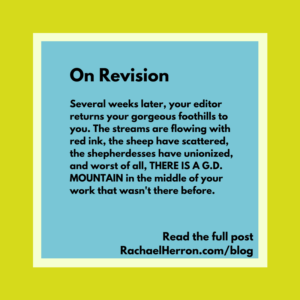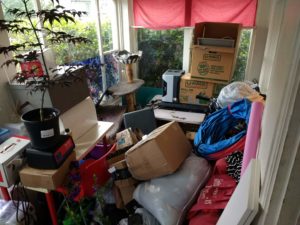
From my weekly writer’s email – are you a writer who should be on the list?
You hear me say all the time that I love revision, that revision is where the magic happens. (Many of you also tell me that I’m out of my mind.)
But I’m here to tell you that once you’ve revised three or four books, you’ll love revision more than first drafting (and if you don’t, then at least you’ll be way less scared of it than you were on your first few buckin’ bronco rides).
Listening to Joanna Penn’s interview with Natasa Lesik on my run yesterday, I heard something that I thought was a great metaphor.
Revising helps you see the mountain hiding in the mist.
I’m going to take that metaphor and unpack it until I can see the bottom of the suitcase and mix my metaphors at the same time! One of my favorite hobbies!
When you write your first, messy draft, you’re digging up dirt. You’re driving your spade into the soil of your soul and tossing it behind you.
I did this in real life just two weeks ago as I dug a hole in the backyard for a Japanese maple. I didn’t realize how much dirt I’d dug out until I turned around and saw it piled there behind me. It was a tiny, unexpected mountain.
The same thing happens in writing. You spend weeks and possibly years digging into your soul, pulling out a book, and patting the dirt back into place.
You’re left with lots of lovely, rolling foothills.
You say, “Oh, these are certainly charming. I’m going to revise my book now, and in these green and verdant foothills, I’ll place picturesque sheep and perhaps a shepherdess or two, with pretty staffs and cunningly laced shoes. A few babbling brooks, and a little tidying, and I’m done!”
What about that mist?
“Oh, that?” you say, looking over your shoulder. “That’s just mist.”
Is it hiding anything?
You look surprised. “Just more of the same, I think.”
More foothills?
You say with way too much confidence, “Sure!”
Then you hire an editor.
She takes your foothills into her arms (she’s very tall) and says, “I’m just going to have a look, okay?”
Several weeks later, she returns your foothills to you. The streams are flowing with red ink, the sheep have scattered, the shepherdesses have unionized, and worst of all, THERE IS A GODDAMN MOUNTAIN in the middle of your work.
“Oh, that,” your editor says, looking over her shoulder as she leaves. “I blew away all that mist for you. That should help.”
A mountain?
You didn’t write a mountain.
And you certainly didn’t write a mountain that you’d have to climb. You don’t have ropes, you don’t have crampons, you barely know what a belay device is.
Then you read her revision letter, and in it, she refers to the multiple times you’re going to have to climb this goddamn mountain that you DID NOT EVEN ORDER THANK YOU VERY MUCH.
What happened to your beautiful foothills? Weren’t they enough?
With all the love my heart can hold, I tell you, No, it’s not enough.
I’ve heard reading a revision letter likened to hearing a nuclear explosion. You’re left with nothing but deafening silence. People speak to you, moving their mouths, but you can’t hear the words they say.
Nothing makes sense, especially your revision letter.
But in another couple of days, the words do start to make sense (this comes slowly). In about a week, you can admit that yes, perhaps it might be a good idea to climb a few feet up the mountain. NOT VERY FAR, MIND YOU. You’re still not sure about any of this. But you buy a pickaxe and a couple of locking carabiners from REI.
Here’s the thing, my sweet friends: THE MOUNTAIN WAS ALWAYS THERE. You built it. All of it came right out of the deepest part of you.
You just couldn’t see it until someone whose gift it is to see things from on high (that’s why she’s tall) showed you the way. She drew a map for you. That doesn’t mean you have to follow the map (though I think you should—she knows more than you do about the shape of good books, no matter how smart you feel you are about your book), but the map is there if you need it.
If you get a good editor, either through your publisher (traditional publishing) or have paid for one (self-publishing), she’s given you a satellite phone. If you get stranded at the top, you can email her. I’m at the peak. There’s no way down.
She’ll email back: Don’t worry, there is. Then she’ll tell you where to start looking for the path back to your foothills.
Then you get to the bottom of the mountain. You did it! You really did it!
Now, do it again.
Happily, the second time over the mountain is way easier than the first. Oh, here’s the peak that looks like Bob Hope’s nose! There’s the stream where you caught that huge trout last time! The third time is even easier—you’re kind of jogging up the path now and sprinting down it on the other side. The fourth time is pure pleasure as you plant flowers and tidy avalanches along the way. All subsequent trips feel like afternoon jaunts to a place you love to be.
Then you become a guide. You take others to this place and show them around.
Those people you take to the mountain are your readers.
And that is amazing.
Onward!








